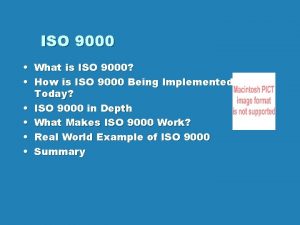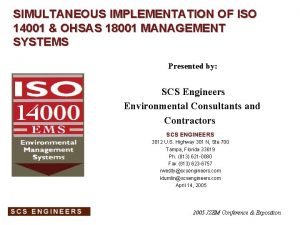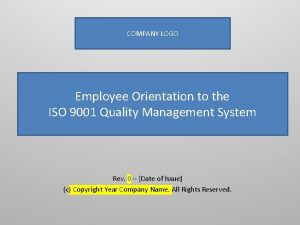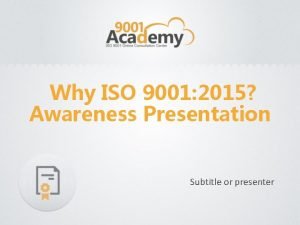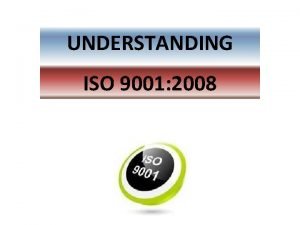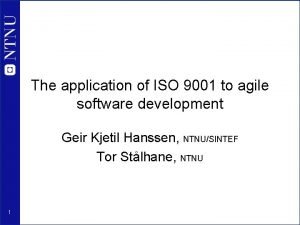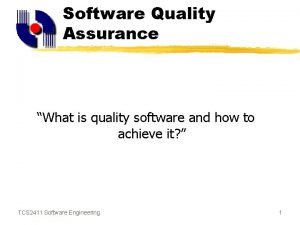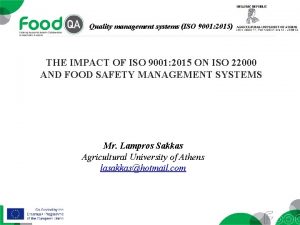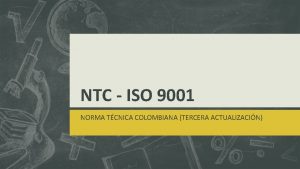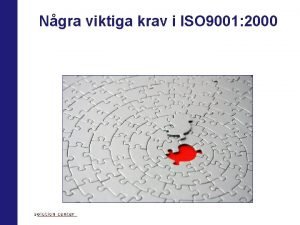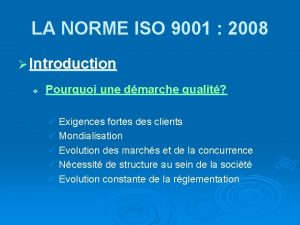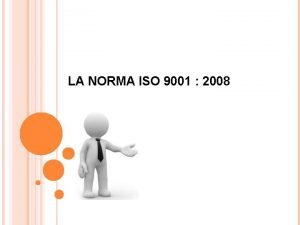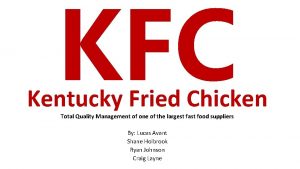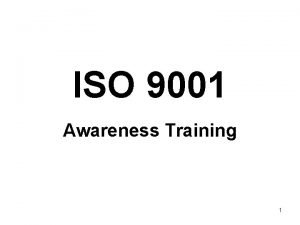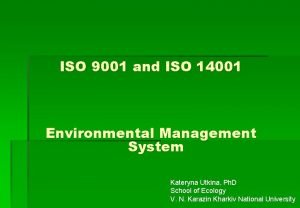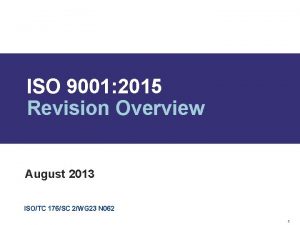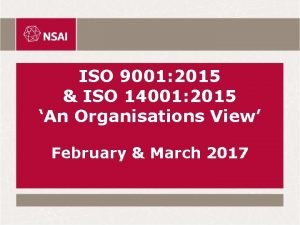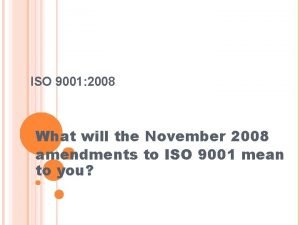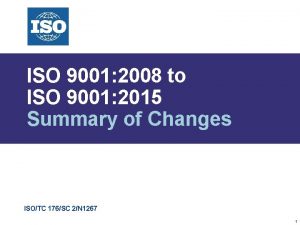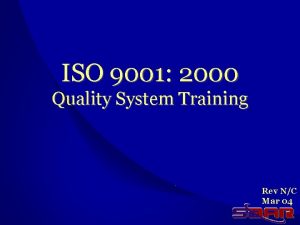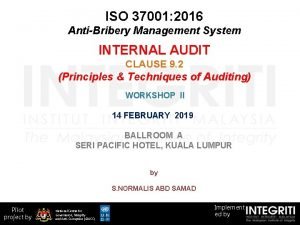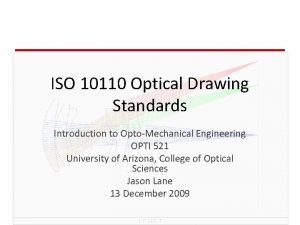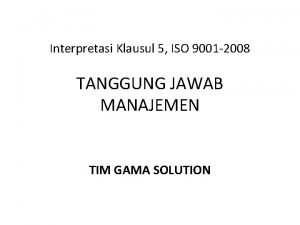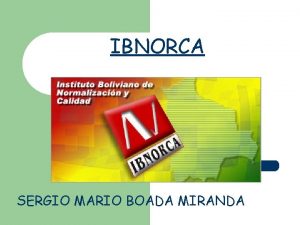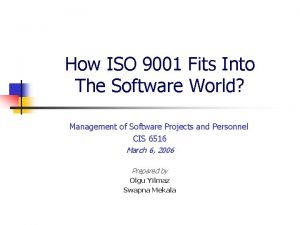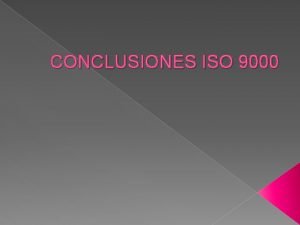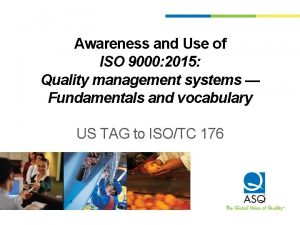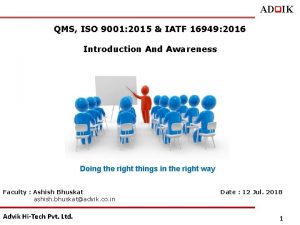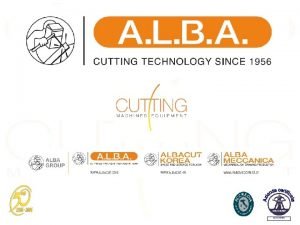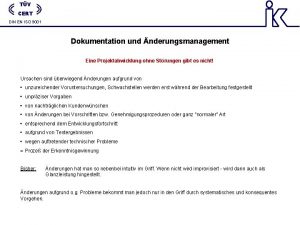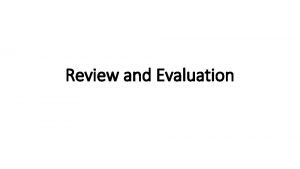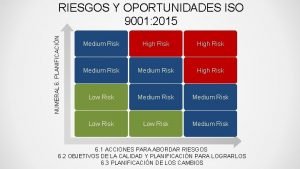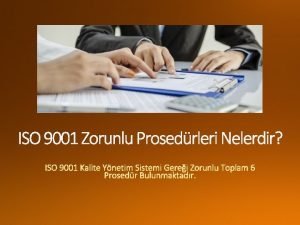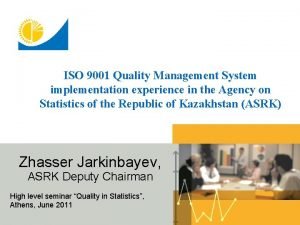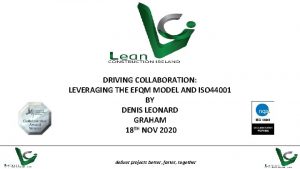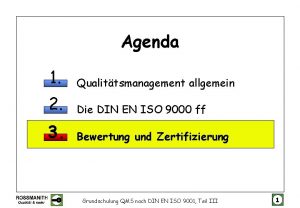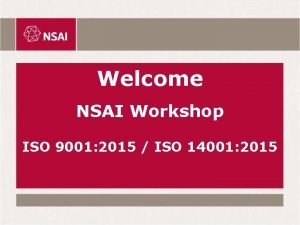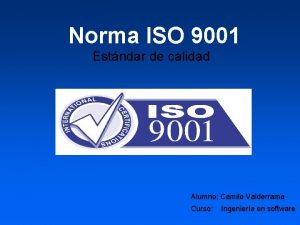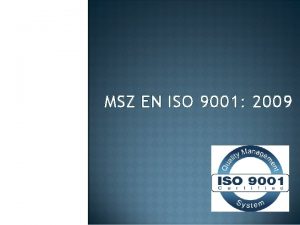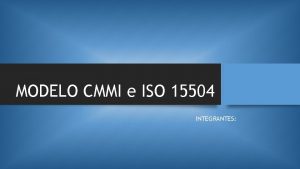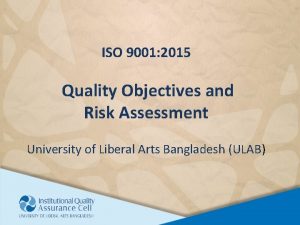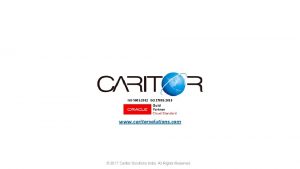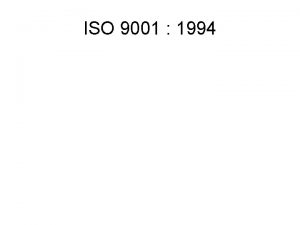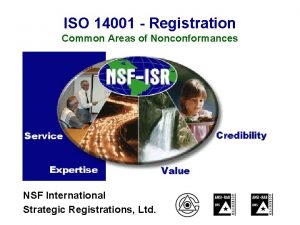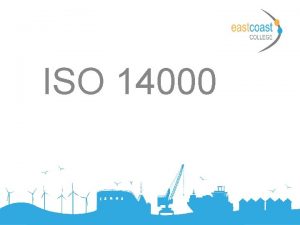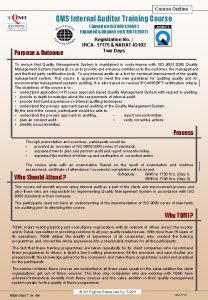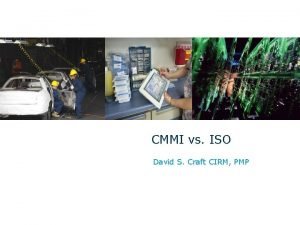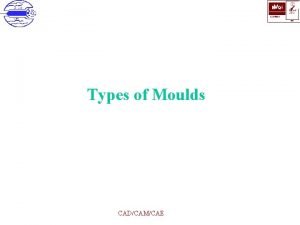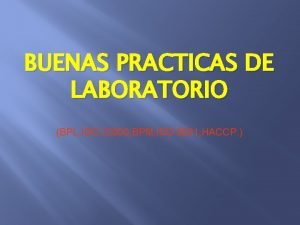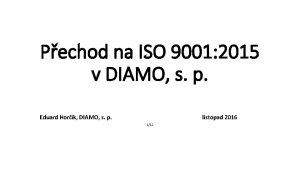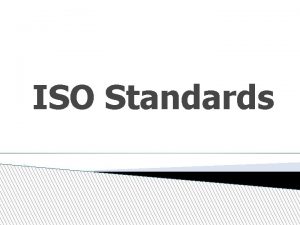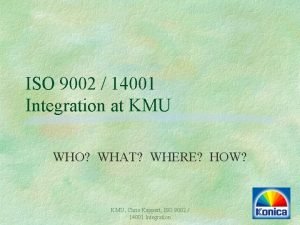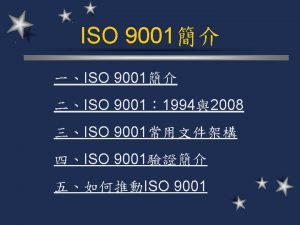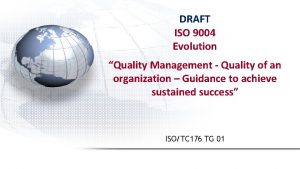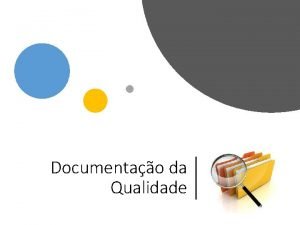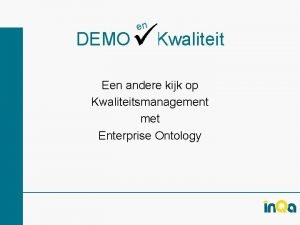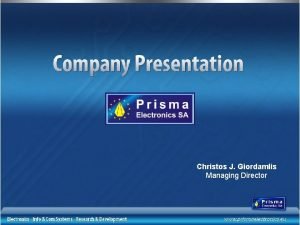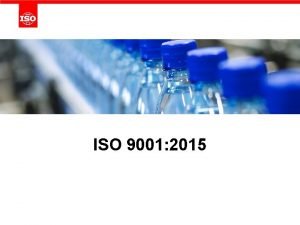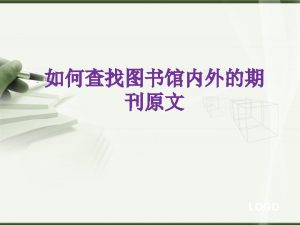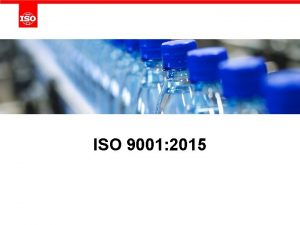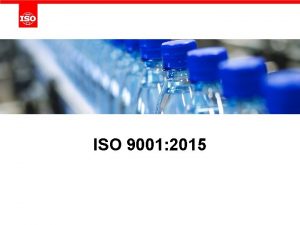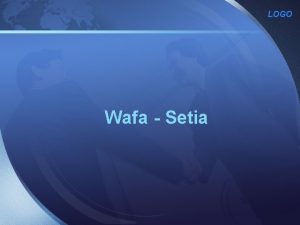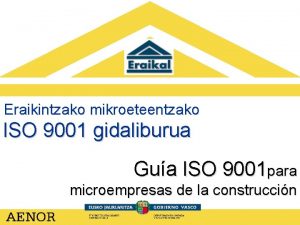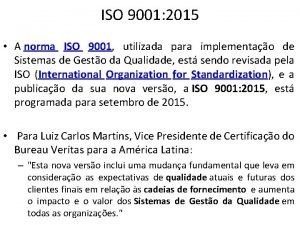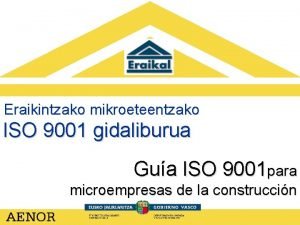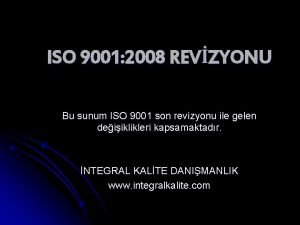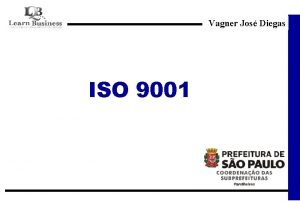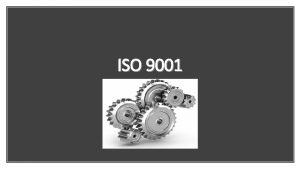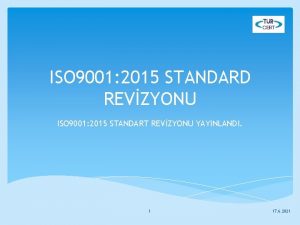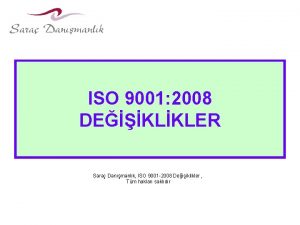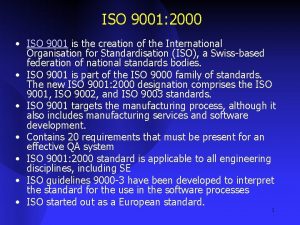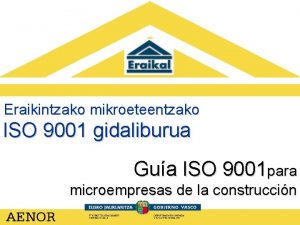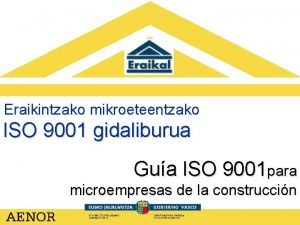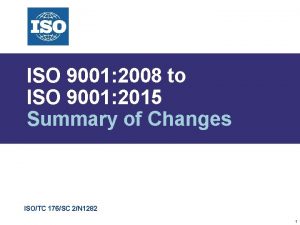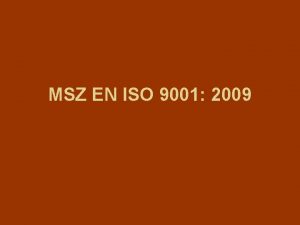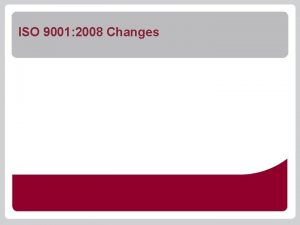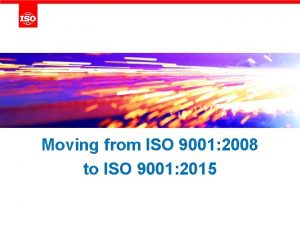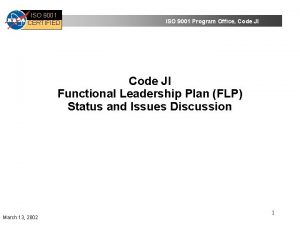COMPANY LOGO Employee Orientation to the ISO 9001





















































![What is a [CAR Form Abbreviation]? • A [CAR Form Abbreviation] is a form What is a [CAR Form Abbreviation]? • A [CAR Form Abbreviation] is a form](https://slidetodoc.com/presentation_image/066d37179b21eabdeab6419055e9771d/image-54.jpg)
![[CAR Form Abbreviation] Form • This is the [CAR Form Abbreviation] form • Copies [CAR Form Abbreviation] Form • This is the [CAR Form Abbreviation] form • Copies](https://slidetodoc.com/presentation_image/066d37179b21eabdeab6419055e9771d/image-55.jpg)






- Slides: 61

COMPANY LOGO Employee Orientation to the ISO 9001 Quality Management System Rev. 0 – [Date of Issue] (c) Copyright Year Company Name. All Rights Reserved.

Part One What Is A Quality Management System?

Quality Management System (QMS) Q M S • “Quality” means “meeting customer requirements. ” • • • Form, fit, function of hardware products Quality of services provided Prompt delivery Product/service Consistency Customer service Responsiveness to customer complaints

Quality Management System (QMS) Q M S • “Quality Management” is the activities performed by the company to ensure those customer requirements are met. • Inspections • Measurements • Customer feedback review • Improvement activities

Quality Management System (QMS) Q M S • “Quality Management System” is the set of processes a company utilizes to execute its quality management activities. • The processes in the company that impact on quality • Management of those processes through objectives and metrics • Improving those processes to enhance quality and customer satisfaction

Quality Management System (QMS) • Every company has a quality system in place whether it knows it or not. • The QMS may be: – Good or bad – Formal or informal – Documented or undocumented

Two Quality Systems Joe’s Pizza • Amount of dough, cheese, etc. • Spices used • Oven temperature • Bake time • Boxes used • Delivery methods (pick up, deliver by car, etc. ) ABC Machine Shop • Make parts according to prints • Use raw materials from approved suppliers • Inspect parts before shipment • Repair defects found • Package properly • Ship all parts express

Standardizing Quality Systems • Because a company can have any kind of quality system it wants, customers do not know in advance whether the system is good or bad. • Does a company inspect its work before delivery? • Does a company have a way to handle complaints? • Does a company use good raw materials? • Are employees properly trained?

Enter ISO • The world recognized that this was a problem. • The International Organization for Standardization (ISO) intended to correct this, by standardizing quality systems.

What is ISO? • ISO is based in Geneva Switzerland. • Over 160 countries are members of ISO, including the US. • ISO develops all kinds of standards, such as traffic symbols, material standards, inspection practices, and more.

Example: an ISO Standard ISO standardized credit card sizes • If credit cards didn’t comply with ISO 7810, they wouldn’t physically fit in bank machines Source: Wikipedia

What is ISO 9001? • In 1987 ISO published “ISO 9001” a document (or standard) that lists some internationallyaccepted, basic rules for a model quality system. • Remember: – “ISO” is an organization – “ISO 9001” is a document

ISO 9001 “Rules” • ISO 9001 does nothing more than just list some rules for managing a company’s quality system. • These rules have been recognized by the world as generally-accepted “good practices”

Adopting ISO 9001 • Companies voluntarily adopt the ISO 9001 rules in order to prove that their systems are: – GOOD – Based on internationally-accepted criteria – Meet minimum requirements for quality

Certification • Anyone can SAY they comply to ISO 9001. So “certification” was developed. • Certification (or “registration”) to ISO 9001 is accomplished through regular, recurring “audits” by an independent ISO registrar, who comes on-site and inspects the company’s compliance with the standards.

Our Intent • It is our company’s intent to implement the common sense rules of ISO 9001 and then certify it. • Our certification body (or “registrar”) is [your registrar’s company name]. • The registrar will audit us periodically to ensure we are complying with ISO 9001. Registrar Logo (if registrar is known)

Part Two Our Quality System

What We Have Based our System On • Our quality system is unique. • It is based on: 1. 2. 3. 4. 5. The company Quality Policy Customer requirements Employee requirements Other stakeholder requirements ISO 9001 requirements

Your Responsibilities • Everyone in the company has a responsibility to understand improve the quality system. This means: • Understand the Quality Policy • Understand the Quality Manual (managers and supervisors) • Understand the Procedures related to your area • Make suggestions for improvement, or report existing problems

Documentation • Quality System Documents – Quality Manual – Procedures – Forms • Technical Documents – Drawings – Specifications – MPPs Customize this whole slide to reflect actual practice

Where to Find Documents • Our server • Specially marked binders in your area. • Document Department. Customize this whole slide to reflect actual practice NOTE: • If you have documents that are not under revision control, please forward them to the management and we will place them on the server. • Contact management if you are unable to locate a document.

Quality Policy ENTER QUALITY POLICY HERE

Understanding the Quality Policy • As an employee, you must be familiar with the Quality Policy as it defines how you should approach everything you do while working with our company. • PLUS, auditors will ask you what the Quality Policy is and how it affects your job.

Quality Manual • Derived from the Quality Policy is the Quality Manual. • Again, it not only addresses how we meet the requirements of the Quality Policy, but also those of ISO 9001. INSERT GRAPHIC OF COVER OF QUALITY MANUAL HERE

Quality Manual Customize this and whole • The Quality Manual must be read by all managers slide to reflect actual supervisors. practice • You must be sure to implement those requirements in your department or area. • All other employees may read it optionally. • Some of it will not apply to your position.

Procedures • Procedures must be read by affected employees. • That means you only need to read and understand the procedures that apply to your work. • These give more detailed descriptions of how to carry out tasks, operate equipment, etc.

Work Instructions • (If you have work instructions in addition to procedures, add a slide here discussing the work instructions in general, and how they are different from procedures. ) • If you don’t use work instructions, delete this slide.

Controlled Documents • Manuals, procedures and forms are Customize this whole “controlled” to ensure you have the latest slide to reflect actual practice information. • Use only hardcopy procedures and manuals issued by management. • Or you may use electronics files pulled from the server files. • Do not photocopy controlled documents. • Do not mark up controlled documents.

Do Not Use Uncontrolled Docs • These are: Customize this whole slide to reflect actual instructions NOT practice – Manuals, procedures, specs or issued by management. – Documents you’ve written yourself and have not sent in for control. – Documents from other companies. – Documents without revision numbers or letters. – Documents marked “OBSOLETE” – Documents you know are obsolete.

Anything that INSTRUCTS • Any document that instructs – tells you what to do – must be controlled. • This means charts, logs, diagrams or any other document created for our company which tells an operator how to do something.

Forms • You may write on and photocopy forms. • Always be sure you are using the latest revision of a form by checking with your supervisor or with the management Customize this whole slide to reflect actual practice

Correcting a Record • If you make a mistake when entering data on a hardcopy form, it is important not to use correction fluid (which eventually flakes off). • The proper method is:

Correcting a Document • We don’t want employees blindly following procedures if they are wrong, or just bad. • If you find something wrong with a document, you can see that it gets fixed! • Submit a [CAR Form Abbreviation] when you find an error in a document.

Part Three Other Rules of the Quality System

Management’s Job • ISO 9001 and our Quality System require top management: • • • Care about quality Care about the customers Promote quality and the customer Assess risks and opportunities Supply necessary resources Measure and monitor the company’s performance

Training • All employees must be trained to bring them up to speed for position requirements • Training must also be done to continually improve how we do things

Understand the Customer’s Requirements • Contracts must “capture” and review all customer requirements. • This is to ensure we can actually make what the customer wants. • This must happen before we take an order.

Purchasing • Items we purchase for use in our products must be bought from proven suppliers. • We have to clearly tell the supplier what we want. • We have to monitor supplier performance.

Production Controls • When we make product, we must: Make sure we plan first Use approved equipment Use approved methods Preserve the product (good handling, packaging, etc. ) • Keep products properly identified • NOT use expired chemicals or material • •

Calibration • Tools used in inspection or testing. Customize must this bewhole slide to reflect actual calibrated. practice • Check your tool for a sticker. • If it’s not up to date, NOTIFY QC IMMEDIATELY.

Shop Router Rules • ALL lines to be signed off or marked “N/A” Customize this whole slide to reflect actual • Performing operations out of sequence is okay practice with verbal approval from manager or supervisor • NO OTHER CHANGES TO ROUTERS ALLOWED WITHOUT TALKING TO QUALITY OR ENGINEERING! • No white out!

Nonconforming Parts • Whenever a part fails an inspection or test, it does not conform to requirements, so it is called a “nonconforming part. ” • NCP can be: • Raw materials or parts we receive from suppliers • Parts or products we are in the process of making for our customers. • Finished product ready for shipment to our customer.

Controlling NCP • ISO requires that we identify defective Customize this whole slide to reflect actual material or parts and prevent it from being practice mistaken for good material or parts. • Keep it tagged! • Keep it segregated! • If applicable, keep any nonconformance documentation and/or tags ON THE PART(s)

Things to Consider • How does the quality of my work affect the customer? • How does the quality of my work affect us as a company? • If I do something wrong, how does this affect the customer?

Part Four Quality Audits

What is Auditing? • As part of ISO 9001 and our Quality System, we have committed our company to both internal and external quality audits. • These are not financial audits, or audits by immigration or any other body. • These audits aim to ensure our ongoing compliance with ISO 9001, and to drive internal improvement.

External Audits • As we discussed, we intend to prove to the world it is complying with ISO 9001 through independent audits by a third-party “registrar”. • The Registrar will visit us periodically and compare: – What we do vs. internal procedures – What we do vs. ISO 9001

Ongoing External Auditing • We must pass each audit to maintain ISO 9001 certification. • The auditor may speak with anyone in the company. This may mean you!

Typical Audit Questions • • • What are you doing? How do you do that? Do you have a procedure? Have you been trained? What do you do when something goes wrong? What is the Quality Policy?

Internal Audits • We also have to conduct “internal audits” to ensure we are sticking to our Quality Manual policies and the ISO 9001 requirements. • Some of you will be selected and trained as internal auditors.

Auditing Processes, Not People • Audits are conducted to confirm PROCESS adequacy. • People are not the focus of audits! “YOU” are not audited, the PROCESS is!

Part Five Corrective & Preventive Action

Continual Improvement • One of the requirements of ISO 9001 is that the company must continually improve. • In order to do this, we have implemented the [CAR Form Abbreviation] program. • Supervisors and Managers must become familiar with this!
![What is a CAR Form Abbreviation A CAR Form Abbreviation is a form What is a [CAR Form Abbreviation]? • A [CAR Form Abbreviation] is a form](https://slidetodoc.com/presentation_image/066d37179b21eabdeab6419055e9771d/image-54.jpg)
What is a [CAR Form Abbreviation]? • A [CAR Form Abbreviation] is a form submitted whenever we have to report: – A report of a problem – A customer complaint – A customer return • If you find a problem, notify your supervisor, who will initiate a [CAR Form Abbreviation], as needed.
![CAR Form Abbreviation Form This is the CAR Form Abbreviation form Copies [CAR Form Abbreviation] Form • This is the [CAR Form Abbreviation] form • Copies](https://slidetodoc.com/presentation_image/066d37179b21eabdeab6419055e9771d/image-55.jpg)
[CAR Form Abbreviation] Form • This is the [CAR Form Abbreviation] form • Copies are available in QC, the Document Dept. and other locations around the plant INSERT GRAPHIC CAR FORM

Corrective vs. Preventive • The form is used to report EXISTING problems, or things that require a change in order to prevent recurrence. • It is also used for preventive action, to report potential problems, or to prevent occurrence. • It is also used for any employee suggestion for improvement.

The Only Rule • The only rule for submitting a one of these is that the issue you are reporting be somehow quality related. – Do not “write up” people – Do not “grind axes” – Make a quality case for your issue!

Part Six Conclusion

Things to Remember • Understand the Quality Policy • Understand the Quality Manual (managers and supervisors) • Understand the procedures related to your area • Sweep your area for uncontrolled documents! Customize this whole slide to reflect actual practice

Things to Remember • Make suggestions for improvement and report existing problems through the corrective action system • Get ready for an audit!

Questions?
 Norma iso 9000
Norma iso 9000 Iso 9001 iso 14001 ohsas 18001 comparison
Iso 9001 iso 14001 ohsas 18001 comparison Iso company logo
Iso company logo Iso 9001 presentation
Iso 9001 presentation Iso 9001 clauses
Iso 9001 clauses Time representation format
Time representation format Agile iso 9001
Agile iso 9001 Iso 9001 software quality assurance
Iso 9001 software quality assurance Major changes in iso 9001 for 2015
Major changes in iso 9001 for 2015 Norma tecnica colombiana iso 9001
Norma tecnica colombiana iso 9001 Iso 9001 krav
Iso 9001 krav Norme iso 9001 2008
Norme iso 9001 2008 Norma iso 9001:2008
Norma iso 9001:2008 Kfc quality management
Kfc quality management Itil iso 9001
Itil iso 9001 Iso 9001 awareness training
Iso 9001 awareness training Iso 9001 environmental management system
Iso 9001 environmental management system Iso 9001 introduction
Iso 9001 introduction Major changes in iso 9001 for 2015
Major changes in iso 9001 for 2015 Iso 9001:2008 certification in mumbai
Iso 9001:2008 certification in mumbai Iso 9001 summary
Iso 9001 summary Iso 9001 2000 training
Iso 9001 2000 training Abms audit checklist
Abms audit checklist Iso 10110-7
Iso 10110-7 Klausul 5 iso 9001
Klausul 5 iso 9001 Mario boada
Mario boada Iso 9000 vs 9001
Iso 9000 vs 9001 Iso 9000 2000
Iso 9000 2000 Iso 9000 vs 9001
Iso 9000 vs 9001 Iaob iatf
Iaob iatf Alba cutting machine
Alba cutting machine änderungsmanagement iso 9001
änderungsmanagement iso 9001 Iso 9001 customer satisfaction
Iso 9001 customer satisfaction Iso 9001 kapitel 8
Iso 9001 kapitel 8 Matriz de riesgos y oportunidades iso 14001
Matriz de riesgos y oportunidades iso 14001 Iso 9001 zorunlu prosedürler
Iso 9001 zorunlu prosedürler Iso 9001:2012
Iso 9001:2012 Fiche processus ressources humaines iso 9001
Fiche processus ressources humaines iso 9001 Efqm vs iso 9001
Efqm vs iso 9001 Management review iso 9001 version 2015 muster
Management review iso 9001 version 2015 muster Nsai iso 9001
Nsai iso 9001 Iso 9002 wikipedia
Iso 9002 wikipedia Iso 9001 2009
Iso 9001 2009 Cmmi niveles de madurez
Cmmi niveles de madurez ıso 9001:2015 kalite el kitabı örnekleri
ıso 9001:2015 kalite el kitabı örnekleri Iso 9001:2015 risk assessment example
Iso 9001:2015 risk assessment example Iso 9001:2012
Iso 9001:2012 Iso 9001 1994
Iso 9001 1994 عید 14001
عید 14001 Iso 9001 family
Iso 9001 family Iso 9001 2000 auditor training
Iso 9001 2000 auditor training Cmmi vs iso 9001
Cmmi vs iso 9001 Bvqi
Bvqi Bpm y bpl
Bpm y bpl Iso 9001:2012
Iso 9001:2012 Iso 9001 acronym
Iso 9001 acronym Iso 9002 vs 9001
Iso 9002 vs 9001 Iso 9001
Iso 9001 Iso 9001 evolution
Iso 9001 evolution Lista mestra de documentos iso 9001:2015
Lista mestra de documentos iso 9001:2015 Procesmodel iso 9001
Procesmodel iso 9001 Laros iso 9001
Laros iso 9001
